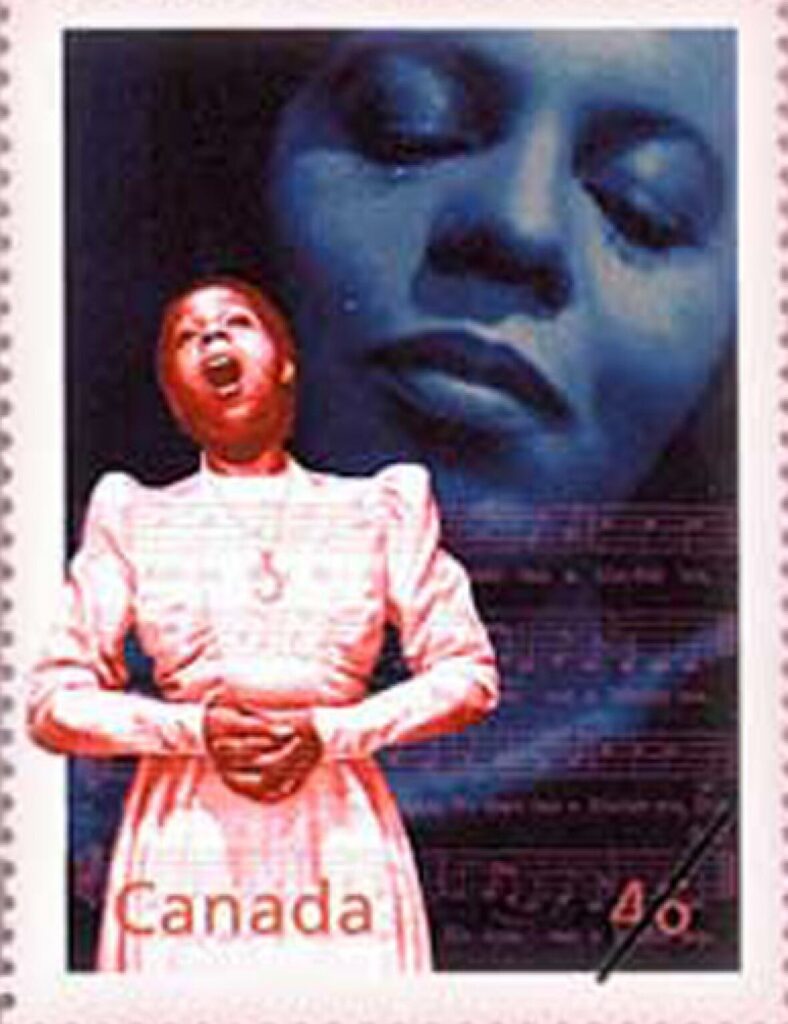(1911 – 1968)
With thanks to Portia White’s niece Sheila White for her support in writing this piece.
“To Portia White’s Song Recital in Dalhousie Gym & to reception after at Government House.” {May 18 1946}
“Portia White phones from New York, asking me to accompany her at Acadia University May 17th.” {April 25 1947}
“Rehearsal with Portia p.m. & accompanied her in Recital at Acadia evening. Large audience, & several visitors from Halifax. Reception after at Dr. & Mrs. Lunsden’s.” {May 17 1947}
“To the Baccalaureate service at Acadia morning & accompanied Portia in one short song.” {May 18 1947)
. . . . . . .
“Played & sang to pupils of Annapolis Royal Academy at their 1939 School. Last night’s concert {at Annapolis Royal Community Centre} was great event for a small centre. Everybody very hospitable & appreciative.” {September 24 1947}
“Miss … drives Portia & me to Fredericton (via Sussex & Cambridge) for concert in Normal School Auditorium … Full house of about 700 with some standing.” {September 29 1947}
“To London (Ontario) with Portia White for concert at the University. Stayed Hotel London. Attendance estimated at 1000. Hall holds 700.” {November 23 1947}
“Portia’s concert at Newcastle … United Church Hall full.” {January 28 1948}
Those initial encounters with contralto Portia White coincided with George’s early life in Canada. She was one of the very first to perform with him in the role for which he would become most known, as a musical collaborator, a capable and supportive partner, concertizing with singers and many other musicians.
Their successful collaborations led to a colossal tour of the Maritimes in 1948 – 10 weeks and 31 concerts in Nova Scotia, Prince Edward Island and New Brunswick.
Master photographer Yousuf Karsh captured Portia White’s portrait in 1946. She was recognized as a Person of National Historic Significance by the Canadian government, and in 1999 was commemorated on a Canadian postage stamp.
It’s easy enough to forget someone whose dreams for what she could accomplish left a legacy that paved the way for many others who came after. Here then is a short summary of Portia’s life:
Portia was the third of thirteen siblings; her father was a Baptist minister whose parents were slaves turned landowners, and community pillars in Virginia, and her mother was descended from Black Loyalists. She trained as a classical singer in her home province of Nova Scotia. After triumphant debuts at Toronto’s Eaton Auditorium in 1941 and New York’s Town Hall in 1944 (the first Canadian to perform there), she went on to concertize in Europe, the West Indies, Central and South America. The City of Halifax and the Province of Nova Scotia established a trust fund to enable her to pursue her music career, which still exists to this day.
This was an era when Black artists experienced outright discrimination. To give a well-known example, in 1939 the famed Black American contralto, Marian Anderson, though acclaimed internationally, was refused by the Daughters of the American Revolution (DAR) the opportunity to sing to an integrated audience at Constitution Hall in Washington D.C. This injustice caused a furor that resulted in the resignation of thousands of DAR members including First Lady Eleanor Roosevelt.
Portia White, however, was remarkably unconscious of race. She had friends everywhere and had attended an interracial school. She did not meet a large degree of discrimination until she travelled to the U.S. Then she was shocked. Although she was celebrated on the international stage, meeting and singing for dignitaries and royalty, in the States she was refused entry to restaurants and hotels simply because she was Black. After her travels in the U.S. she felt more connection and solidarity with people of colour than ever before.
The rigors of Portia’s tour schedule, the demands on her voice and unsatisfactory management of her career took their toll. Having started singing professionally relatively late at age 30, she retired from full-time performing a decade later and became a sought-after voice teacher in Toronto working with well-known Canadian theatre and television performers, also teaching at Branksome Hall, a highly-regarded school for girls in the city.
In the recitals and interviews available online one notices her beautiful demeanor and hears her rich voice, also the seriousness and intensity with which she strives to convey the depths of meaning in both the art song repertoire and the spirituals she always turned to. You can hear her artistry in a recital she gave, recorded and preserved on YouTube:
TOUR OF NOVA SCOTIA, PRINCE EDWARD ISLAND, NEW BRUNSWICK,
Early February till late April 1948:
During the tour Portia and George criss-crossed three provinces. Many of the concerts were in churches and were sprinkled here and there with organ recitals given by George, also groups of piano pieces to fill out the vocal recitals.
To hear them must have been an utter delight for the audiences of many of these places, some quite out-of-the-way where people probably had little opportunity to experience touring classical musicians.
The tour took them to New Glasgow, Sydney & North Sydney, Glace Bay, Antigonish, Mahone Bay, Bridgewater, Liverpool, Shelburne, Lockeport, Yarmouth, Digby, Bridgetown, Berwick, Windsor, Kentville, Parrsboro (all Nova Scotia); Summerside, Charlottetown (both Prince Edward Island); McAdam, Woodstock, Hartland, Fredericton, St. Stephen, Chipman, Hampton, St. John, Sussex, Bathurst, Newcastle and Moncton (all New Brunswick).
“… good attendance in spite of hockey counter-attraction.” {February 16 1948 (Glace Bay)}
“Very enthusiastic applause” {February 19 1948 (Summerside)}
“Concert … before audience of 1000.” {February 20 1948 (Charlottetown)}
“An enthusiastic audience of about 600.” {March 4 1948 (Yarmouth)}
“Arrived Toronto after 10 wks. absence, during which time we had 31 concerts & 30 receptions.” {April 25 1948}
“Portia White sails for England & Europe from Halifax aboard the Aquitania.” {July 15 1948}

